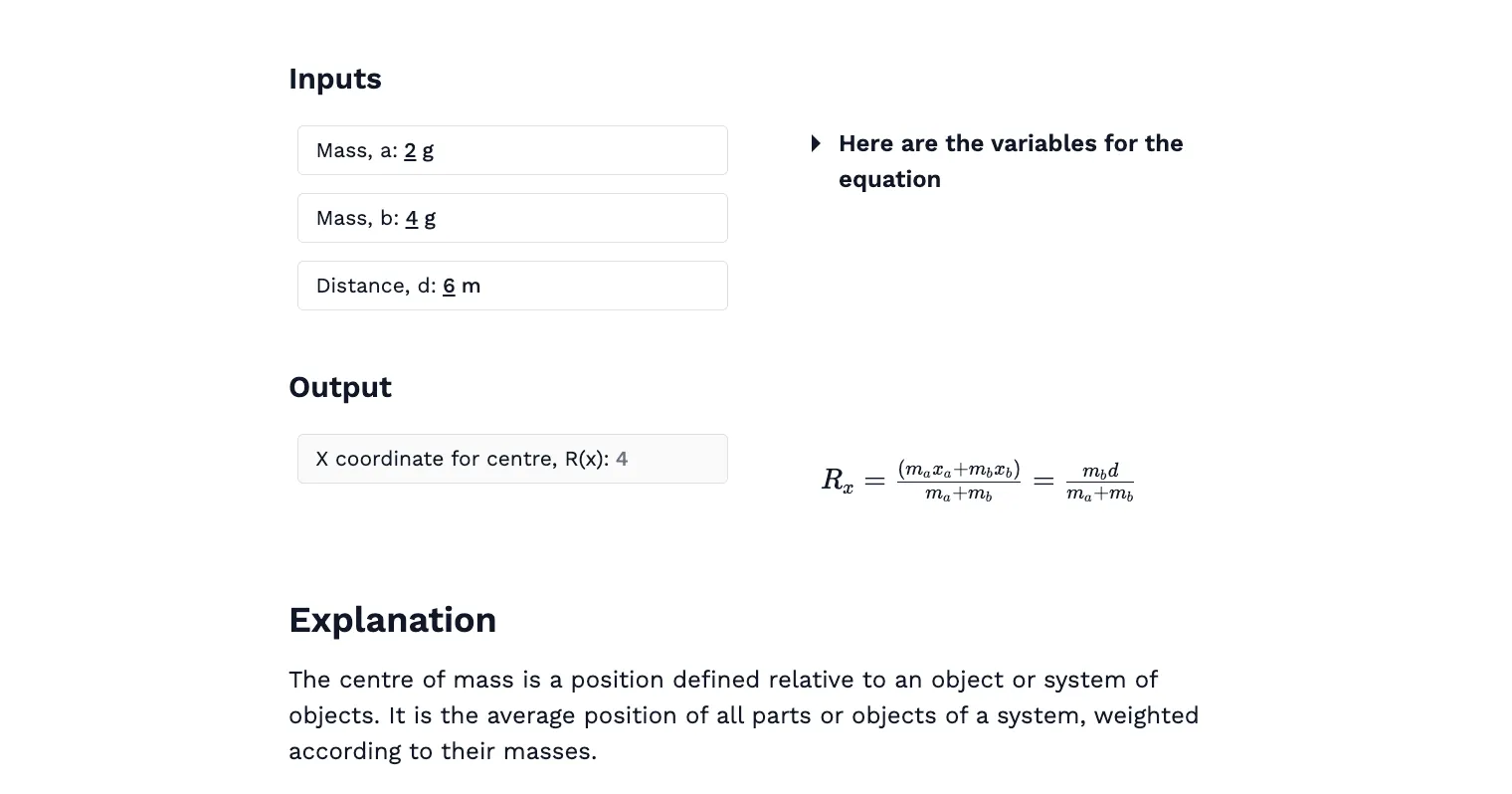Free Centre of Mass Calculator. Step-by-step, engineering-grade tool with downloadable report.

This template is not available yet. You can sign up and create it yourself!
Or let us know if you'd like to be notified when it’s ready:
About this 'Center of Mass Calculator'
The Center of Mass Calculator is an intuitive tool designed to help users determine the center of mass for two arbitrary masses. In essense, the center of mass is the exact point where your entire system of objects would balance if supported at just one location. Think of it as the average position of all the mass in the system—where gravity acts as if the whole mass were concentrated. This concept is fundamental in mechanics, engineering design, and stability analysis.
This calculator is for:
- Physics Students: Explore the fundamental principles of mechanics and develop a deeper understanding of mass distribution.
- Mechanical Engineers: Quickly determine the center of mass for components during the design and analysis of systems.
- Educators and Trainers: Demonstrate the concept of the center of mass in practical scenarios for enhanced learning.
The Centre of Mass Calculator allows you to perform quick feasibility checks for balancing systems or predicting motion behavior. The result you'll receive is based on a standard formula that accounts for both the mass and position of each object, the mass calculator center:
$$x̄ = (m₁x₁ + m₂x₂ + ... + mₙxₙ) / (m₁ + m₂ + ... + mₙ)$$
This equation takes a weighted average of the position coordinates, meaning heavier objects pull the center of mass closer to them. If all the masses in your system are equal, then the center of mass lies exactly halfway between them. However objects with greater mass or those positioned farther from the reference point have more influence on the center of mass location. In two- or three-dimensional systems, the same approach is applied to the y and z axes. The result is a point in space—(x̄, ȳ, z̄)—that represents the effective location of the total mass.
This is especially useful in engineering applications. For example in;
- Mechanical systems, knowing the center of mass helps in ensuring a part is balanced or rotates correctly.
- Vehicle design, a low and centered mass improves handling and reduces rollover risk.
- Structural engineering, it helps determine how forces are distributed, especially under load or in motion.
If your system includes uniform density shapes or point masses, the same logic applies. The calculator is built to support both cases. It handles linear systems, planar models, and 3D configurations by adapting the formula to the data you input.
Behind the scenes, the calculator sums up the individual products of each mass and its respective position, then divided by the total mass. This gives you a precise and meaningful result—ready to be used in force calculations, pivot point analysis, or dynamic simulations.
In systems where the mass distribution is uneven or complex, this tool saves time by eliminating the need for manual calculations.
For in-depth theoretical knowledge, refer to textbooks like Fundamentals of Physics by Halliday, Resnick, and Walker, or Engineering Mechanics: Dynamics by J.L. Meriam and L.G. Kraige.
Introduction to Mass Calculator
The mass calculator is a versatile and practical tool designed to help users determine the centre of mass across a wide range of systems—whether you're working with simple one-dimensional setups or more complex two- and three-dimensional configurations involving point masses. By entering the individual masses and their corresponding positions, engineers can quickly visualise how mass is distributed within the system. This concept is a cornerstone of both physics and engineering, as mass distribution directly influences how objects behave under forces like gravity and how they maintain structural stability.
The mass calculator uses the mass equation to relate the masses and their distances from a chosen reference point, making it easy to calculate the center of mass for multiple objects. Whether you are analysing a single object or a system of several masses, this tool provides a straightforward solution for determining the center point where the whole mass of the system can be considered to be concentrated. It’s especially useful in applications involving force analysis, mechanical balance, motion prediction, and system design.
How the Mass Calculator Works
The mass calculator works by applying the mass formula to the values you provide for each object’s mass and its coordinates. For systems with uniform density, the calculator uses the following formula to find the center of mass along the x-axis: center of mass = (m1x1 + m2x2 + … + mnxn) / (m1 + m2 + … + mn), where each m represents a mass and each x represents its distance from a reference point. For two-dimensional systems, the same approach is used with y coordinates, and for three-dimensional systems, z coordinates are included as well. By entering the masses and their respective positions, the calculator determines the total mass and calculates the precise location of the center of mass, which acts as the pivot point for the system. This is especially important for maintaining balance and stability, as the center of mass is the point where the system’s mass is effectively concentrated. The mass calculator is designed to deliver accurate results for systems with multiple objects, making it an invaluable tool for students, engineers, and anyone interested in understanding the physics of mass distribution. With its user-friendly interface, the calculator simplifies complex calculations, allowing you to focus on analyzing the system and applying the results to real-world problems involving forces, motion, and equilibrium.
Engineering templates
Common calculators
Design guides
FAQs
Can the center of mass lie outside the physical body?
Yes, in systems like hollow or irregularly shaped objects, the center of mass can lie outside the physical boundaries of the object.
How do you determine the center of mass for multiple objects?
To find the center of mass for multiple objects, the weighted positions of all objects are averaged, using their respective masses as weights.
What is the difference between center of mass and center of gravity?
While the center of mass is the average location of mass in a system, the center of gravity is the point where the gravitational force acts. They coincide when the gravitational field is uniform, meaning the center of mass and center of gravity are equal in this case.
Learn about the benefits of using CalcTree on engineering projects!


